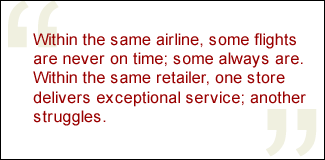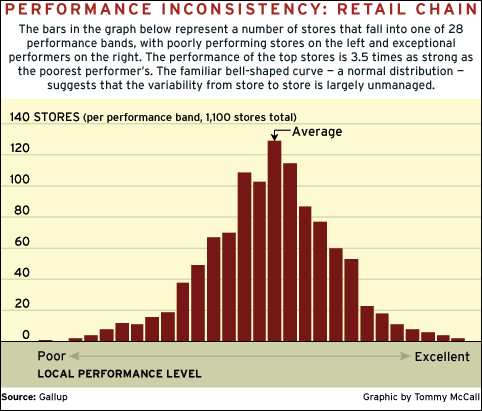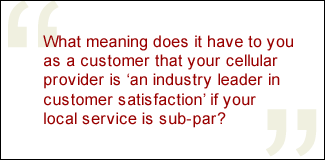As advisor to the U.N. Conference on the Human Environment, Rene Dubos believed that global environmental concerns could be addressed only by considering the cultural, economic, and ecological conditions that exist within the local environment. Sustainable global environmental change, he argued, could not be achieved by focusing action at a global level, but would result only from the cumulative impact of thousands upon thousands of local changes.
 |
His phrase "Think globally, act locally" summarizes this "bottom-up" change philosophy. Dubos's focus on and call to local action has considerable relevance for business leaders who aspire to drive consistency and create sustainable improvements in the quality of the customer experience within their organizations. It is surprising, however, how few of those leaders heed this sage advice.
But what does "Think globally, act locally" really mean in business? The answer lies in the ways the metrics that many of us use to manage our businesses every day are deployed. Take these claims, for example: A major airline touts itself as an industry leader in on-time performance and has the flight departure and arrival data to prove it. An apparel retailer claims to be an industry leader in customer satisfaction, citing an independent study of customers in the category.
These "summary" claims may indeed be legitimate, but even a quick review of the on-time performance of specific flights or candid conversations with customers who shop in the store's different locations will inevitably reveal a considerable range in the quality of the customer experience hidden behind those averages. Within the same airline, some flights are never on time; some always are. Within the same retailer, one store delivers exceptional service; another struggles to drag customers through the door. (See "The Constant Customer" in the "See Also" area on this page.)
High-level performance summaries not enough
High-level summary measures (averages) of the effectiveness of our companies' customer experiences may make potentially useful marketing claims and may even make executives and managers feel better about their overall performance in the marketplace. But because they obscure the staggering inconsistency in the effectiveness of that experience from location to location within the company they are inadequate to provide managers and executives with the information and tools they need to manage effectively and improve performance.
This pattern of inconsistency (local variability) reveals several key insights. First, variation in the effectiveness of the customer experience within a company is vast. In fact, the variability within a company easily dwarfs the differences between competitors. In the graphic "Performance Inconsistency: Retail Chain," this kind of inconsistency in the effectiveness of the customer experience is brought to life by creating a frequency histogram of the chain's 1,100 stores' performance on their key customer metric. Each bar represents the number of stores that fall into one of a number of discrete performance bands, with poorly performing stores on the left and exceptional performers on the right. In this case, the best performer's performance is 3.5 times as strong as the poorest performer's. If you had to choose one of this retailer's stores in which to shop, which one would you choose?
 |
Second, because the histogram produces the familiar bell-shaped curve, the pattern of performance is roughly normally distributed, suggesting that variability from location to location is largely unmanaged. From the customer's perspective, this is critical because customers experience variation, not averages. Customers are sensitive to the consistency (or a lack thereof) of a company's products or services. For sales and services organizations with a high degree of direct employee-customer interaction, substantial variability in the customer experiences they create represents a significant threat to the sustainability of the enterprise.
Must operate at the local level
The existence of a high degree of inconsistency within a company suggests that the only way to reduce that variability and improve local performance is to provide customer feedback at the level within the organization where that variability originates -- at the local level where customer interactions occur and where the customer experience is created -- the store, the bank branch, the local office, or sales team. Because most managers' spheres of influence are circumscribed and local, the customer metrics they rely on to manage must also be focused locally.
But because customer metrics in many companies are measured at too high and too general a level, they fail to reveal the true range of performance variability that actually exists within the organization and fail to provide insight at those levels within the company where real improvement can be made. What meaning does it have to you as a customer that your cellular provider is "an industry leader in customer satisfaction" if you are routinely confronted with sub-par service at a local level? And what good is it to know that your local apparel retailer is a leader in customer satisfaction when the experience you have in their local store is routinely unacceptable?
 |
When the customer experience is assessed at the right level within the company, a fascinating new perspective emerges. Consider this example from "Telecom R," a major long-distance telephone services provider. To assess how well it meets customer requirements, Telecom R regularly measures the customer experience at the total-company level by surveying a random sample of customers who have recently called the customer service call centers. When the company's quarterly customer scorecard is distributed, it indicates that 88% of customers nationwide who contacted one of the company's call centers were satisfied with the service they received.
But as a local manager, what exactly does this information tell you? As anyone who has tried to use this type of information can attest, not very much. To truly understand the totality of the customer experience, you have to deploy your metrics much deeper into the organization. When you do, you will make some startling discoveries.
Down to first point of contact
One of those discoveries -- borne out by one of the largest CSR-level studies ever conducted -- is that in spite of the very latest in technology tools, processes, and systems, a typical call center customer's experience still depends largely on the particular CSR to whom he or she ultimately speaks. In this case study, a random sample of customers who had interacted with each of Telecom R's 4,600 CSRs was interviewed and each CSR received his or her unique performance scorecard. For Telecom R, the best 10% of CSRs produced a 6:1 ratio of positive to negative customer interactions. That is, for every six customers who in a post-contact interview evaluated their interactions with those CSRs positively, just one customer left the experience feeling alienated.
What's more, a small cadre of seven CSRs consistently delighted every single customer they talked to. The worst 10% of CSRs, in contrast, yielded a 3:4 ratio, meaning that for every three customers who were delighted with their interactions with those CSRs, another four customers exited the experience feeling alienated. Paralleling the performance of the very best performers, the very worst performing CSRs actually managed to alienate every single customer they spoke to.
And all of this critical performance information was hidden behind an overall summary score of 88% customer satisfaction. Without understanding how this variability in the customers' experience plays itself out at the level of the individual CSR, Telecom R would have lacked a critical perspective -- one that now allows the company to identify the sources of both poor and exceptional performance and to manage them.
Greater the inconsistency -- greater the cost
Understanding local performance variability is critical to improving the effectiveness of the customer experience. More than two decades ago, Drs. Edwards Deming and Joseph Juran noted that the presence of variability on critical performance metrics is a threat to the vitality of an enterprise because it is prima facie evidence that the business is not being managed effectively. And intuitively, the greater the range of performance on critical performance measures, the more costly -- both in terms of actual operating expenses as well as revenue loss (i.e., customer defection) -- the business is to operate.
 |
Inconsistency from location to location is the scourge of organizations that aspire to high performance. Moreover, the magnitude of that inconsistency is itself a critical measure of organizational health. Unfortunately, in most companies, this variation in the effectiveness of the customer experience goes largely undiagnosed. As a result, inconsistency remains large and largely undetected, bleeding off revenues and profits and resulting in anemic growth.
Interestingly, companies spend millions of dollars annually in efforts to create a consistent, coherent brand image and position. Our research suggests that much of this investment is squandered. The extensive variability in the customer experience from location to location means that each location -- and each touchpoint -- creates a different and inconsistent version of the brand, some that bear little or no resemblance to the brand that executives back at headquarters believe they are building. In short, there are often as many different "brands" as there are local units and customer touchpoints.
But where does inconsistency come from? The kinds of inconsistency described in the examples above are not limited to call centers, grocery stores, or banks. They play themselves out each and every day in companies of all types, large and small, in different industries around the globe.
In the face of this kind of performance variability, it is tempting for managers to explain away the variable performance from location to location as the result of factors that either cannot be changed or that are constant across the enterprise and must be managed centrally -- factors such as store age, location, store size, local market demographics, common processes and systems, and the presence or absence of competition. Yet Gallup research reveals that even after the effects of these variables have been removed from the analysis, inconsistency in the effectiveness of the customer experience persists.
Something of a paradox
This presents something of a paradox. If we assume that the traditional arsenal of marketing weaponry (the 4 "P"s of Product, Price, Promotion, and Place plus Processes and Policies) remains relatively constant within the same company, then these variables cannot provide an explanation for the observed inconsistency in the customer experience. These factors, which often play a critical role in driving and sustaining the customer experience, must be managed centrally. Improvement methodologies such as Six Sigma are ideally suited for managing these kinds of factors.
Ruling out these 6 "P"s as causes of local variability leaves us with just one set of factors to explain local inconsistency: local management and differences among the local associates who interface with customers. For example, if customers within a branch perceive sub-par performance on the bank's processes or policies, the process or policy itself cannot be the root cause, since these do not differ from branch to branch. Instead, the search for a root cause must focus on how those processes and policies are implemented in the local branch.
The successful implementation of standardized processes, policies, and other "constant" drivers of high-quality customer experiences brings us back to a consideration of exactly who is doing the implementing and how that implementation is being managed. For this reason, businesses must focus on reducing variability in local "people" processes (the "who" and "how" of implementation) rather than on the process itself to reduce local performance variability in the customer experience. The power of an approach focusing on reducing local performance variability lies in its simplicity and flexibility, allowing each local "unit" to identify and correct its own local causes for disengagement.
As Ralph Waldo Emerson once noted, "A foolish consistency is the hobgoblin of little minds." But in the not-so-little mind of your customer, consistency is absolutely essential for delivering a world-class customer experience that emotionally engages them.
Put another way, foolish inconsistency is the hobgoblin of mediocre companies. The challenge of creating a consistent, high-quality customer experience at every location and touchpoint hinges, first, on understanding the degree of inconsistency that exists, and second, on managing to reduce that inconsistency with the goal of creating strong emotional connections with each and every customer rather than rigidly enforced adherence to a strict set of guidelines that confuses process with the desired result. Only then will the customer experience -- and ultimately overall business performance -- begin to improve.
|
Achieving Consistency: A Two-Pronged Approach In "Reflections on Quality," quality guru Phil Crosby noted that "quality has to be caused, not controlled." But in seeking to reduce the inconsistency in the customer experience they create, many companies today have sacrificed quality in favor of control -- they have eschewed a focus on the ultimate customer outcome they desire to create in favor of controlling the processes through which the experience is delivered. It is as though they have written quality in a tiny four-point font next to control in gigantic 40-point font. This is perhaps understandable as it is far easier to try to control the process than it is to cause the desired outcome. In seeking to manage consistency and reduce variability in the effectiveness of the customer experience, two approaches are possible. The first, or executional consistency, approach emphasizes the consistent execution of the steps in service delivery, assuming that flawless execution of those steps will result in a superior customer experience. The executional consistency approach seeks to control all of the elements of the customer experience through a rigidly defined and enforced set of steps and procedures. This kind of approach has led to the implementation of all manner of processes and systems designed to enhance the customer experience by outlining and in some cases legislating the specific steps of service delivery, often going so far as to script the actual behaviors of employees. The creation of behavioral checklists (smile, use the customer's name, etc.), SOPs (standard operating protocols) that attempt to anticipate, define, and control every customer exigency that could possibly emerge, and automated systems are the hallmarks of this approach. Not surprisingly, the executional consistency approach relegates the human elements of the customer experience, such as individual initiative, talent, and personality, to a secondary role in the process. Our experience working with companies around the globe suggests that the executional consistency approach will only help poor performers to become merely mediocre. It will not help good performers to become great. The second, or outcomes consistency, approach stands in stark contrast, emphasizing that the ultimate goal of the customer experience is to develop a strong, healthy emotional relationship with each customer. Processes and systems, customer service training, and a host of other activities are all used to support the creation of strong customer relationships. Most important, however, is that the outcomes consistency approach emphasizes the unique role of the individual employee in building strong customer relationships and recognizes that no two individuals will achieve the desired outcome -- strong, emotionally engaged customer relationships -- in exactly the same ways. Under the outcomes consistency approach, employees are selected and developed for their talents and abilities to engage customers rather than their ability to follow a predetermined script of behaviors. Again, our experience suggests that the world's best companies are able to create a superior and consistent customer experience only by embracing the outcomes consistency approach. While no one would argue that executional consistency is unimportant, consistency in execution has become an end unto itself in many organizations, rather than a means to a higher end. As a result, the customer experience in many companies has become routinized, impersonal, and process focused. And ultimately, the quality of the customer experience has suffered and become variable. |
This article originally appeared in Customer Management, and is reprinted with permission. Customer Management is a publication of Quest Media Limited.